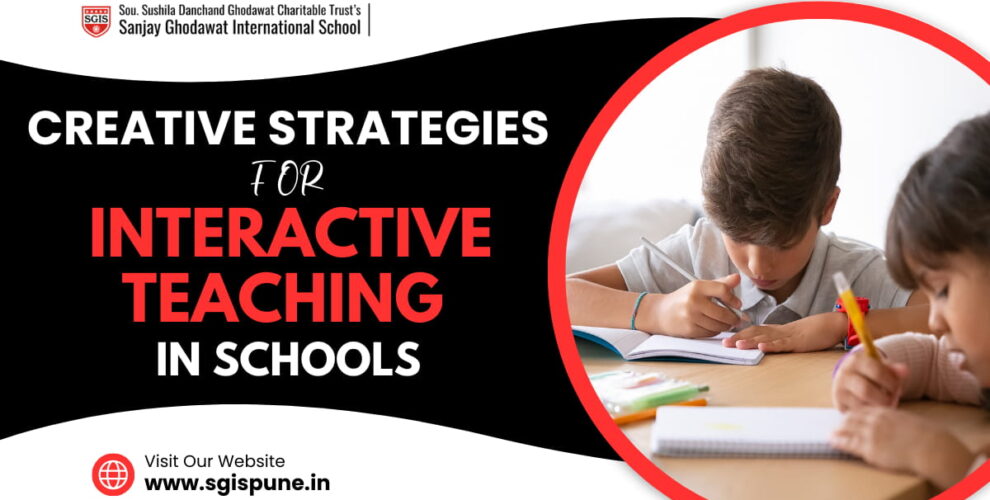Education empowers an individual to make well-informed choices in all aspects of their life. Schools are the medium that lets a child grow into an independent and accountable person. Successful and top schools in India through interactive teaching encourage students’ engagement in learning and developing their critical thinking skills.
Schools’ medium of teaching greatly impacts the student’s ability to solve problems, make informed decisions, and understand their responsibilities for their family, community, and country. This blog will present the top 7 student engagement strategies that, by designing opportunities and resources, can foster an interactive learning environment to support students’ learning.
Top 7 Creative Strategies for Interactive Teaching in Schools
1. Think-Pair-Share
The first creative strategy that can foster interactive teaching in schools is think-pair-share. This active learning strategy involves pairing class students and then giving them questions on a certain topic. Students will first individually think about the answer to the question for a short time. After that, they will talk about their ideas with their companions. Lastly, after concluding, each pair will present their answers to the whole class. This activity develops the communication and thinking abilities of students.
2. Brainstorming
Brainstorming is among the most helpful student engagement strategies that foster an engaging learning setting for students. Students work in groups in a collaborative brainstorming session to find solutions to a single topic. This activity helps students to learn from each other’s ideas. Teachers can create a temporary setup in classrooms for this interactive session. A teacher must encourage and ensure that the thoughts of every student in the class are heard during this activity.
3. Debate
Debate is a highly interactive teaching strategy that helps students learn and develop a variety of skills. A forced debate session allows students to explore and discuss real-life world issues and topics. This activity helps students to develop their critical thinking ability, persuasive writing and speaking ability, and a deeper understanding of complex issues. Debates positively impact the writing, speaking, and listening abilities of the students.
4. Interactive Classroom Technology
A classroom equipped with modern technological teaching mediums, such as whiteboards and projectors, allows students to understand new concepts through images and videos. These technological mediums are optimal student engagement strategies for student involvement that enhance learning. Teachers can teach students about new topics and complex concepts easily through videos, pictures, presentations, etc. with the help of interactive classroom technology.
5. Peer Teaching
Peer teaching is an interactive teaching activity that improves students’ understanding, speaking and presentation skills, and self-confidence. This activity involves teachers and students exchanging their roles. Students work to learn, understand, and deliver a lecture on a particular topic assigned by their teachers. However, for students with lower academic capability, it could be challenging. Teachers can assist them by providing the right guidance for their instructor lecture sessions.
6. Project-Based Learning
For the development of self-directed learning and creative skills in students, project-based learning is one of the most acceptable student engagement strategies. Teachers can assign different topics for projects for different groups of students. Students work together in groups to gather information, plan, and create their project assignments. The creativity of students is positively influenced by this activity.
7. Role Play
Role play is a significant interactive teaching tool that helps students improve their vocabulary by learning new words and developing them into confident communicators. This activity involves building stories and imaginative scenarios that enhance students’ ability of imagination and creativity. Role play can be organized in different languages, which can help students learn more foreign and national languages. This practice fosters emotional intelligence in students as they interact with others.
What is the Significance of Interactive Teaching in Schools?
Many significant benefits are posed by student engagement strategies in teachers’ teaching and students’ learning, which are:
- A sense of community is developed as students work together during different interactive teaching activities to solve the given problems. It also fosters understanding between them.
- Students can visualize new concepts or complex topics through interactive technological mediums. Technology allows students to engage better in the learning process.
- Experiential learning activities allow students to talk about their experiences, get answers to inquiries, and get insightful input from their teachers.
- Students actively participate in interactive teaching activities, such as discussions, debates, role play, etc., that help boost their self-confidence and reduce stage fear.
Give your child the best education possible with Sanjay Ghodawat International School:
SGIS Pune, with its global recognition for preparing future leaders, is the reliable option for parents who want to ensure their kids receive the greatest education possible. We do not only focus on the academic excellence of children but instill in them moral values and lifelong skills. Our experienced and well-qualified faculty, through the best interactive teaching activities, not only focus on students’ memorizing power but also the development of their critical thinking, problem-solving, social, and other important skills.
SGIS has a perfectly planned campus that includes advanced labs, modern classrooms, healthcare facilities, and separate spaces for sports like cricket, tennis, horse riding, football, swimming, etc. We understand the importance of an interactive classroom environment on a student’s learning ability and promote collaborative and active learning through various student engagement strategies.








[…] Also read – Creative Strategies for Interactive Teaching in Schools […]